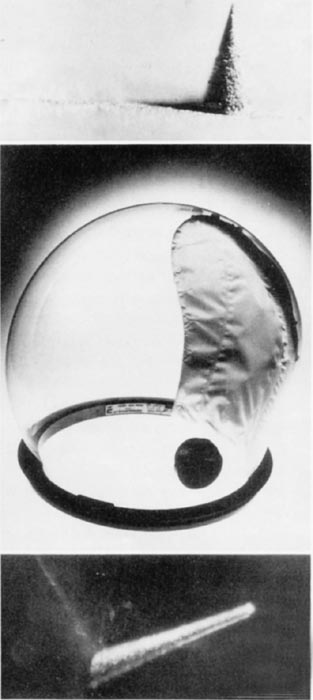
This Article From Issue
July-August 1998
Volume 86, Number 4
DOI: 10.1511/1998.31.0
Tracks to Innovation: Nuclear Tracks in Science and Technology. Robert L. Fleischer. 192 pp. Springer-Verlag, 1998. $49.95.
A heavy ionizing particle passing through a polymer or an electrical insulator can displace electrons and produce localized chemical changes that persist. With the appropriate materials, the disrupted regions surrounding the particle path can be chemically etched at faster rates than the surrounding undamaged material, and one can observe a "track" in the etched solid that matches the path of the original ionizing particle.
This relatively simple effect and the many applications that can be derived from etched tracks provide the basis for this book by one of the early investigators in the field. The book is written in an easy, conversational style and provides insight into the processes that led the author and his associates to carry out studies that elucidate the factors behind etched tracks. Much of the book is devoted to applications, from micro-pore filters to earthquake detection and age measurement in minerals. The book emphasizes the diversity of the applications that are already derived from track etching and provides some insight into potential directions for this technique.

From Tracks to Innovation.
One aspect of the technique that increases its usefulness: It is possible to etch tracks in solids hundreds of millions of years after the initial ionizing events produced the damage tracks. The density of tracks in a solid allows an inference of the energy that produced them. Or, if something is known about the radiation flux, the solid's exposure time can be determined. These characteristics make the technique particularly useful for measuring an integrated radiation exposure (to determine safe radon levels in homes) or an interval in which radiation exposure has occurred (to put dates to minerals and archaeological specimens).
One fascinating aspect of the subject is the ease with which basic observations can be made of etch tracks in solids. Virtually any high school science laboratory with a few chemicals and a microscope can develop observable particle tracks in mica or plastic films exposed to high-energy particles. Yet by precisely calibrating the methods employed, the technique is capable of producing information on the nature of the ionizing particle or its energy.
Other examples explored by the author are the use of track etching in oil exploration, nuclear particle physics, effects of thermal events on track characteristics and the measurement of gas flows within the earth. A major subtheme of the book is to show how a simple process can find application in a wide variety of fields and lead to the development of a number of enterprises that further develop the capabilities of the method. A related theme is the importance of industrial laboratories in the development of techniques like track etching and their role in the commercial applications that arise from the technique.
The book is intended as a general overview of the subject and not as a definitive work on all developments in track etching. Much of the emphasis is on the early work at General Electric Co., and most chapters contain few references more recent than the 1980s. However, it provides an excellent historical discussion of the development of the field, and the book will serve as a useful introduction of the subject. Many of the photographs of etch tracks in the book are striking, and the narrative provides a highly interesting review of the investigations that led to the development of this field.—Thomas S. Elleman, Nuclear Engineering, North Carolina State University
American Scientist Comments and Discussion
To discuss our articles or comment on them, please share them and tag American Scientist on social media platforms. Here are links to our profiles on Twitter, Facebook, and LinkedIn.
If we re-share your post, we will moderate comments/discussion following our comments policy.